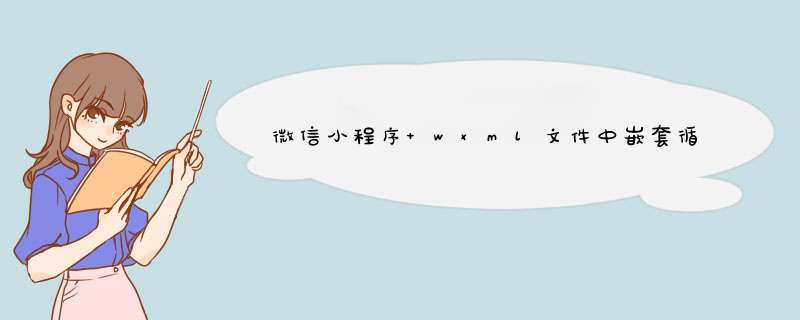
1、服务器获取到的数组中嵌套 对象组成的数组,控制台输出:
2、解析并绑定服务器获取到的数据,js文件:
3、绑定一层的shopList数据, wxml文件:
4、绑定shopList数组中的二层equips数据,wxml文件 中 只需要itemequips即可
最开始循环获取到数据后,总以为需要嵌套循环出二层数组对象,并分别绑定数据。兜兜转转绕了一大圈,发现只要将一级数组循环获取到,二层数组对象直接“itemxxx”就可以在wxml文件中直接进行数据绑定了。
在组件上使用 wx:for 控制属性绑定一个数组,即可使用数组中各项的数据重复渲染该组件。即wx:for指令用于循环数组数据,生成组件。
循环出来的每一项通过item返回,每一项对应的索引,通过index返回。
wx:key="",设置每一项唯一的标识。循环列表时,添加wx:key的好处是,将来列表发生变化时重新渲染列表的损耗为更低。
使用 wx:for-item 可以指定数组当前元素的变量名,使用 wx:for-index 可以指定数组当前下标的变量名:
条件渲染可以使用 wx:if 或 hidden 。
一般来说,wx:if 有更高的切换消耗而 hidden 有更高的初始渲染消耗。因此,如果需要频繁切换的情景下,用 hidden 更好;如果在运行时条件不大可能改变,则 wx:if 较好。
wx:if用于条件渲染:条件为真生成里面的内容,条件为假不会生成里面的内容。(每次重新生成内容)
也可以用 wx:elif 和 wx:else 来添加一个 else 块。
hidden用于条件渲染:条件为真隐藏里面的内容,条件为假显示里面的内容。(每次切换样式)
在appjson文件中添加tabBar节点。tabBar是小程序客户端底部或顶部tab栏的实现。
color: tab上的文字默认颜色,仅支持十六进制颜色。
selectedColor: tab上的文字选中时的颜色,仅支持十六进制颜色。
backgroundColor: tab的背景色,仅支持十六进制颜色。
borderStyle: tabbar上边框的颜色, 仅支持 black / white。
position: tabBar的位置,默认值是: bottom,仅支持 bottom / top。当 position 为 top 时,不显示 icon。
custom: 自定义tabBar。
list是一个数组,它定义了tab的列表。只能配置最少2个、最多5个tab。
pagePath: 页面路径,必须在 pages 中先定义。
text: tab 上按钮文字。
iconPath: 路径,icon 大小限制为 40kb,建议尺寸为 81px 81px,不支持网络。
selectedIconPath: 选中时的路径,icon 大小限制为 40kb,建议尺寸为 81px 81px,不支持网络。
跳转到普通页,可以直接通过返回按钮返回。
navigateTo()方法,用于跳转普通页面。可以直接通过返回按钮返回。
页面js文件中添加方法:
redirectTo()方法,关闭当前页面再跳转到指定页,不能通过返回按钮返回页面。该方法不能用于跳转tabBar页面。
页面js文件中添加方法:
跳转到tabBar页面,通过tabBar按钮返回。
如果要使用navigator组件跳转tabBar页面,需要设置open-type="switchTab"。
switchTab()方法,用于跳转tabBar页面。
页面js文件中添加方法:
标签数据在data中定义, 因为还要点击高亮, 所以同时给个状态值
页面循环渲染出来
点击事件bindtap='select',
绑定class: class="{{itemisSelect'active':'select'}}", 点击的时候改变类名
自定义dataset :data-index="{{index}}"
样式效果
JS部份
到这儿, 高亮的就已经写好了 怎么取值呢 下面还有一个保存按钮 给保存按钮一个点击事件:
1定义一个空数据
2遍历上边的data里的selectall数组, 传两个参数, v是所有标签的状态(比如isSelect:false或isSelect:true), i是下标
看打印结果
1、请求获取的数据赋值给页面data中;
2、页面 wx:for循环输出 并每个item中添加bindtap点击事件 clickid(itemid)
3、js中clickid点击事件中 就拿到id了
clickid(id){
consolelog(id)
}
1使用内置组件scroll-view
2实现点击时出现的背景样式
3使用scroll-into-view,实现点击时自动滚动
前言
本次主要内容是介绍页面tab的开发,如何实现tab与页面内容联动呢?关注我就知道!
本次效果展示
一、如何实现页面tab
1使用内置组件scroll-view
如下图所示,我们需要使用到红色框框中的属性,此属性可也实现滚动
这里有一个大坑,不管是使用scroll-x还是scroll-y遍历数据都是出现在左边一数列(这里我们只关注scroll-x、scroll-y)
<scroll-view scroll-x="true" class='scroll-view-t' :scroll-into-view="scrollinto">
<view v-for="(item,index) in 20 " :key='index' :id="'tab'+index"
:class="currentIndex==index'active':''" @click="changeTab(index)">
{{item}}
</view>
</scroll-view>
<scroll-view scroll-y="true" :style="'height:'+scrollH+'px'">
<view v-for="(item,index) in 100 " :key='index'>
{{item}}
</view>
</scroll-view>
我们只能通过样式来改变它,让它横过来
scroll-view-t view {
display: inline-block;
font-size: 32rpx !important;
margin: 0 15rpx;
}
scroll-view-t {
white-space: nowrap;
height: 88rpx;
line-height: 88rpx;
}
2实现点击时出现的背景样式
这里我们需要定义一个默认的索引currentIndex,在通过点击事件所传出去的索引进行判断,从而获得当前所点击的对象给到样式,样式我们就用三元表达式判断赋予样式,如下点击方法
changeTab(index) { //nabbar栏点击切换
// if (thiscurrentIndex === index) return
thiscurrentIndex = index
// thisscrollinto = 'tab' + index
// if (thiscurrentIndex < 10) {
// thisscrollinto = 'tab0'
// }
},
如下是绑定的点击事件和三元表达式判断赋予样式,其中背景样式提前写好了
<view v-for="(item,index) in 20 " :key='index' :id="'tab'+index"
:class="currentIndex==index'active':''" @click="changeTab(index)">
{{item}}
</view>
不过现在只实现了通过点击样式发生改变,感觉实现了tab切换,眼下要解决点击时tab这个导航条也要自己滚动起来,不能一边手动滚动,然后再点击吧
3使用scroll-into-view,实现点击时自动滚动
使用它的目的主要是,在点解tab时可以实现,你向那个方向点,他就往那个方向滚动,不过在点回去的时候,就有坑了,需要对其作出判断
阅读文档很难理解对吧,我在这里说说我的理解,这里是想要我们通过在scroll-view中属性scroll-into-view绑定一个元素,此元素还要获得id,此id还不能已数字开头,此id就是移动的关键,需要绑定,所遍历内容的索引,从而实现往哪里滚动,不过想点回去就需要进行判断
如下代码中在scroll-view,使用scroll-into-view绑定了一个自己定义的空元素scrollinto
在v-for遍历后获得了索引,id就通过索引进行了绑定,拼接了以tab开头
<scroll-view scroll-x="true" class='scroll-view-t' :scroll-into-view="scrollinto">
<view v-for="(item,index) in 20 " :key='index' :id="'tab'+index"
:class="currentIndex==index'active':''" @click="changeTab(index)">
{{item}}
</view>
</scroll-view>
实现点击滚动很简单,要滚动回去就要判断了,如下代码,只要当前的thisscrollinto = 'tab' + index就能实现点击就滚动,回去是就要判断当前点击的缩影,手动赋值,给一个最好的区间,这样效果更好
changeTab(index) { //nabbar栏点击切换
if (thiscurrentIndex === index) return
thiscurrentIndex = index
thisscrollinto = 'tab' + index
if (thiscurrentIndex < 10) {
thisscrollinto = 'tab0'
}
},
效果图
wxml页面
<!-- nav导航 -->
<view class="goods">
<block wx:for="{{tab}}" wx:key="key">
<view class="{{itemstyle}}" bindtap="tarClick" data-index="{{index}}">{{itemtitcle}}</view>
</block>
</view>
<!--导航下 视图滑块 -->
<swiper bind:change="changeTab" current="{{index}}">
<block>
<swiper-item>
<text>11111</text>
</swiper-item>
<swiper-item>
<text>2222</text>
</swiper-item>
<swiper-item>
<text>3333</text>
</swiper-item>
</block>
</swiper>
js页面
Page({
data: {
tab:[
{titcle:"商品参数",style:"color"},
{titcle:"商品介绍",style:""},
{titcle:"商品规格",style:""},
],
index:0,
goods:''
},
tarClick(e){
// consolelog(ecurrentTargetdatasetindex)
let tab = thisdatatab;
let that = this;
let index = ecurrentTargetdatasetindex
consolelog(index)
tabmap((item,key)=>{
if(key==index)
{
tab[key]['style']='color';
}else{
tab[key]['style']='';
}
})
thatsetData({tab,index})
},changeTab(e){
consolelog(edetailcurrent)
let tab = thisdatatab;
let that = this;
let index = edetailcurrent
consolelog(index)
tabmap((item,key)=>{
if(key==index)
{
tab[key]['style']='color';
}else{
tab[key]['style']='';
}
})
thatsetData({tab,index})
},
})
wxss页面
/ pages/details/detailswxss /
goods{
width: 100%;
height: 100rpx;
/ background-color:yellowgreen; /
display:flex;
justify-content: space-around;
align-items: center;
}
goods view{
width: 160rpx;
height: 100rpx;
display: flex;
justify-content: center;
align-items: center;
}
color{
color: red;
border-bottom: 2px solid red;
}
以上就是关于微信小程序 wxml文件中嵌套循环全部的内容,包括:微信小程序 wxml文件中嵌套循环、微信小程序开发——列表渲染 & 条件渲染 & tabBar & 页面跳转、小程序多个标签点击高亮和取值等相关内容解答,如果想了解更多相关内容,可以关注我们,你们的支持是我们更新的动力!
欢迎分享,转载请注明来源:内存溢出

 微信扫一扫
微信扫一扫
 支付宝扫一扫
支付宝扫一扫
评论列表(0条)